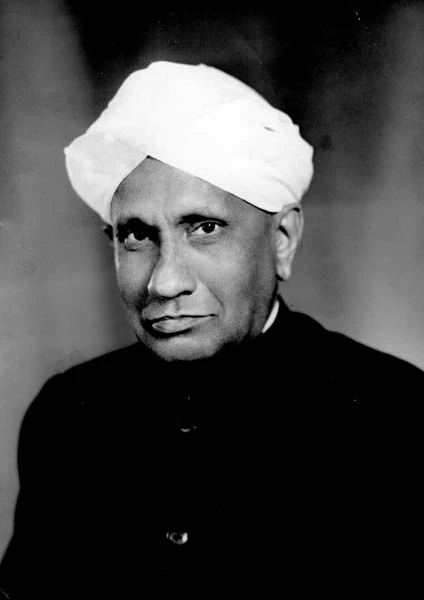C V Raman Biography : C.V. Raman, born Chandrasekhara Venkata Raman, was a pioneering Indian physicist whose groundbreaking discoveries and contributions to science have left an indelible mark on the world. Hailing from a modest family in Tiruchirapalli, Tamil Nadu, Raman’s journey to becoming a Nobel laureate and one of the most respected scientists of his time is a testament to the power of passion, dedication, and intellectual curiosity.
Early Life and Education
C.V. Raman was born on November 7, 1888, to R. Chandrasekhara Iyer and Parvati Ammal. His father, a lecturer in mathematics and physics, fostered an environment that nurtured Raman’s innate love for science from a young age. Raman’s exceptional academic prowess became evident early on, as he passed his matriculation examination at the tender age of 11 and completed his higher secondary education on a scholarship by the age of 13.
In 1902, Raman joined Presidency College in Madras (now Chennai), where he excelled academically. He topped the bachelor’s degree examination in physics, becoming the only student to receive first-class honors. Raman’s academic achievements continued to soar as he obtained his master’s degree in physics, setting new records in the process.
Career and Discoveries
Despite his family’s financial constraints, Raman pursued his passion for science. In 1907, he joined the Indian Finance Service in Calcutta (now Kolkata) as an Assistant Accountant General. However, Raman’s true calling lay in the realm of physics, and he dedicated his spare time to conducting research at the Indian Association for the Cultivation of Science (IACS).
Raman’s early research focused on the areas of acoustics and optics, and he published his findings in prestigious international journals such as Nature, Philosophical Magazine, and Physical Review. His dedication and innovative approach to research soon caught the attention of the scientific community.
In 1917, Raman’s career took a significant turn when he was appointed the first Palit Professor of Physics at the University of Calcutta. This marked the beginning of his “golden era,” a period of immense productivity that lasted until 1933. During this time, Raman conducted groundbreaking research in various fields, including optics, acoustics, and crystallography.
The Raman Effect
Raman’s most celebrated discovery, the Raman effect, came in 1928. Using a spectrograph he had developed, Raman and his student K.S. Krishnan observed that when light traverses a transparent material, the deflected light changes its wavelength. This phenomenon, which they termed “modified scattering,” is now known as the Raman effect or Raman scattering.
The Raman effect was a significant breakthrough in the understanding of light-matter interactions, with far-reaching implications in various scientific fields. It provided experimental proof of the quantum nature of light and laid the foundation for the development of Raman spectroscopy, a powerful analytical tool used in chemistry, physics, and materials science.
Recognition and Awards
Raman’s groundbreaking discovery of the Raman effect earned him widespread recognition and numerous accolades. In 1929, he was knighted by the British government, becoming Sir C.V. Raman. The following year, in 1930, he was awarded the Nobel Prize in Physics for his work on light scattering, becoming the first Asian and the first non-white recipient of the prestigious award.
Raman’s achievements were further recognized through his election as a Fellow of the Royal Society in 1924 and the conferment of the Bharat Ratna, India’s highest civilian honor, in 1954. He also received the Lenin Peace Prize in 1957 and the Franklin Medal in 1941, among other prestigious awards.
Later Years and Legacy
In 1933, Raman moved to Bangalore to become the first Indian director of the Indian Institute of Science. He founded the Indian Academy of Sciences the same year and established the Raman Research Institute in 1948, where he continued his research until his last days.
Raman’s contributions to science extended beyond his groundbreaking discoveries. He played a crucial role in the development of scientific research in India, mentoring numerous students and establishing several research institutions. His unwavering dedication to science and his ability to inspire others have left a lasting impact on the scientific community.
Raman’s legacy continues to be celebrated today. National Science Day is observed in India every year on February 28 to commemorate the discovery of the Raman effect and to honor his contributions to science. His work has inspired generations of scientists and continues to shape the course of scientific research worldwide.
Conclusion Of C V Raman Biography
C.V. Raman’s life and achievements serve as a shining example of the power of human potential and the transformative impact of scientific discovery. From humble beginnings in Tiruchirapalli to becoming a Nobel laureate and a global icon of science, Raman’s journey is a testament to the transformative power of passion, hard work, and intellectual curiosity.
Raman’s discoveries and contributions have not only advanced our understanding of the physical world but have also inspired countless individuals to pursue their dreams and push the boundaries of human knowledge. His legacy continues to inspire and guide scientists, educators, and policymakers in their efforts to promote scientific research and education, particularly in developing nations like India.
As we reflect on the life and work of C.V. Raman, we are reminded of the profound impact that a single individual can have on the course of human history. Through his groundbreaking discoveries, his tireless efforts to promote scientific research, and his unwavering commitment to excellence, Raman has left an indelible mark on the world of science and on the hearts and minds of all those who seek to understand the mysteries of the universe.
Check this out for more such biography
